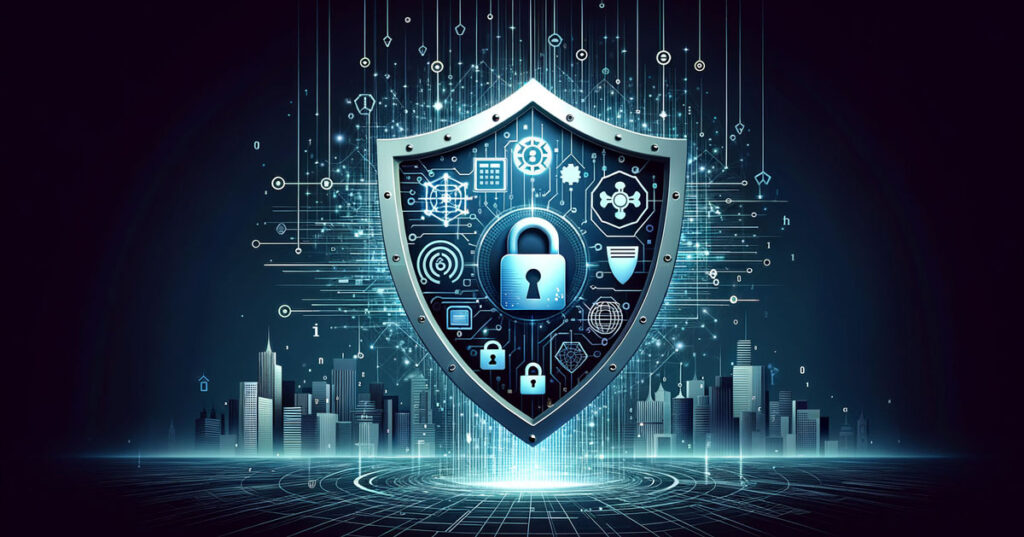Understanding Ransomware
The Rise of Ransomware in the Digital Age
Ransomware, malicious software that denies access to files or systems until a ransom is paid, has sharply increased in the digital age. It targets not only small businesses but also industries such as healthcare, critical manufacturing, government facilities, MSPs (Managed Service Providers), and industrial processes. Preventing ransomware attacks are crucial because these industries face devastating effects, including significant data loss, operational downtime, and reputational damage. Often, these impacts outweigh the ransom cost itself. The National Business Association underscores the amplified threat of ransomware in the digital landscape, making it a pressing concern.

How Ransomware Attacks Occur
Ransomware attacks often start with phishing emails that trick employees into downloading the software. Once the ransomware enters the system, it, classifying ransomware as a serious threat, encrypts files, rendering them inaccessible. The attackers then demand a ransom for the decryption key. The tactics have evolved, moving from obvious phishing attempts to exploiting system vulnerabilities and using deceptive websites. Umetech emphasizes the importance of continuous monitoring and advanced protection to prevent attacks.
Small businesses, the primary target for cybercriminals, are particularly vulnerable due to limited resources. Understanding ransomware attack methods is crucial for building a resilient defense. Regular software updates, sophisticated security layers, and employee training are key proactive measures. Real-time threat detection also plays a crucial role in deterring ransomware success.
The Economic Impact of Ransomware on Small Businesses
The average cost of a ransomware attack for small businesses includes ransom payments, downtime, and recovery expenses:
| Expense Type | Average Cost |
| Ransom Payment | $570,857 |
| Downtime | $1.4 million |
| Recovery Expenses | $1.75 million |
| Total | $3.72 million |
Paying the ransom often does not guarantee data recovery. Around 8% of victims recover all their data after paying the ransom. This highlights the low efficacy of ransom payments in data recovery. Preventative measures are crucial for mitigating damage and restoring operations.
Implementing robust cybersecurity measures is critical for small businesses. It allows them to operate confidently in the digital landscape.
Implementing Strong Cybersecurity Measures
In California, small businesses face growing ransomware threats. They can strengthen their defenses by implementing strong cybersecurity measures, including layered security and advanced threat detection,. There are some well-defined measures to take, for protection against ransomware attacks. These steps can help prevent attacks that compromise sensitive data, interrupt operations, and impose financial burdens.

Building a Robust Backup System
Secure, offline storage for a robust backup system is key to ransomware defense. If attacked, businesses can recover essential information without paying a ransom. This strategy minimizes downtime and prevents data loss.
Regular Software Updates
Cybercriminals exploit outdated software vulnerabilities. Keeping operating systems, antivirus programs, and applying security patches, and other applications up-to-date closes security gaps. Updates are a simple yet effective barrier against ransomware. Recent data shows:
- Most attacks target vulnerable applications and operating systems
- New security measures implementation is continuous
- Regular cybersecurity tests and assessments are crucial
Employee Education and Training
Employee education and awareness training to recognize phishing emails and suspicious email attachments is critical. Knowledge and best practice enhance the company’s security posture.
Multi-Layered Security Measures
Incorporating firewalls, antivirus software, intrusion detection systems, and implementing EDR strategies provides comprehensive protection including intrusion detection systems and network segmentation. These measures detect, prevent, and mitigate ransomware impacts.
Crafting an Incident Response Plan
An actionable incident response plan enables swift action against ransomware attacks. It outlines steps for containment, eradication, and recovery. This reduces potential damage and speeds up the return to normal operations.
Engage Cybersecurity Professionals
Cybersecurity can be complex for small businesses. Engaging cybersecurity services and consulting with professionals gives access to expert advice and tailored solutions. They can identify weaknesses and recommend actions to improve security.
By implementing these cybersecurity measures, small businesses in California can build robust defenses against ransomware attacks. Proactive steps now can prevent financial loss, operational disruption, and reputational damage in the future.
Creating a Culture of Cybersecurity Awareness
Empower Employees as the First Line of Defense
Employees are crucial to your cybersecurity strategy, especially for small businesses in California. Empowering your workforce with the knowledge to identify and respond to cyber threats is key. The National Business Association states that it’s vital to educate employees on recognizing phishing attempts. This turns them into an active line of defense against ransomware attacks. It’s important to familiarize them with common phishing tactics. Research shows that spear phishing and brand impersonation are frequent. Whaling, vendor email impersonation, and PayPal impersonation also happen. Knowing about these methods can improve your human firewall’s effectiveness.
Implement Regular Cybersecurity Training
Cybersecurity training sessions are essential. Cyber threats constantly evolve; what worked six months ago might not be effective now. The U.S. Chamber of Commerce emphasizes the importance of regular training. This training should cover the latest security protocols, safe email practices, and strong passwords. Regular updates ensure everyone can protect the business.
Promote a Security-First Mindset Among Staff
Encouraging a security-first mindset is critical. This idea is supported by Weststar Bank. Staff should be cautious of email links and understand their role in the company’s security. Promoting daily conversations about security fosters vigilance against cyber threats. This reduces the risk of ransomware attacks and strengthens business resilience.
Focusing on these areas helps California’s small businesses build a culture of cybersecurity awareness. It ensures team members are not just informed but also active in protecting the company’s digital health.
Leveraging Technology to Secure Your Business
In the ongoing battle against ransomware, leveraging technology, including vulnerability assessments and penetration testing, is crucial for small businesses in California. By adopting security solutions, endpoint detection, multifactor authentication, and Managed Detection and Response (MDR) and SOC services, companies can improve their resilience against cyber threats.
Employing Advanced Security Solutions
Advanced security solutions include tools designed to detect, prevent, and respond to cyber threats. Firewalls, antivirus software, and intrusion detection systems form a foundational defense layer. Regular updates to these solutions ensure protection against the latest ransomware variants.
Utilizing Endpoint Detection and Response (EDR)
Endpoint Detection and Response strategies monitor and respond to threats bypassing initial defenses. Umetech’s Managed Detection and Response services provide EDR, focusing on monitoring endpoint activities. This approach helps detect anomalous behaviors, enabling swift actions to minimize damage.
Implementing Multifactor Authentication (MFA)
MFA enhances security by requiring multiple forms of verification to grant access. This method combats the vulnerabilities of weak or compromised passwords. According to the US Chamber of Commerce, MFA is an effective step against ransomware attacks. Recent studies demonstrate MFA’s effectiveness:
| Study | Year | Effectiveness |
| Microsoft | 2021 | 99% less likely to get hacked |
| Digital Shadows Photon Research Team | 2020 | Protects against phishing, social engineering, and password brute-force attacks |
| Microsoft | 2019 | Blocked 99.9% of automated attacks |
These findings highlight MFA’s crucial role in cybersecurity defense.
Exploring Managed Cybersecurity Services
Managed cybersecurity services provide small businesses with sophisticated security capabilities. Umetech offers managed cybersecurity services such as penetration testing and a comprehensive security stack. These services ensure round-the-clock monitoring and prompt response to emerging threats.
By leveraging these technologies, small businesses in California can strengthen their defenses against ransomware.
Formulating a Strong Backup and Recovery Plan
Ransomware attacks present a considerable risk to small businesses, potentially causing data loss, operational downtime, and reputational damage. To mitigate these risks, implementing a robust backup system is crucial. By ensuring the continuous backup of critical data in secure, offline locations, businesses can establish a reliable path to recovery that bypasses the need for ransom payments. This approach is supported by the National Business Association, which highlights the importance of a thorough backup and recovery strategy for ransomware protection.

Key Elements of a Strong Backup and Recovery Strategy
To craft a comprehensive backup and recovery plan, businesses must:
- Identify critical data and systems that are essential to operations and prioritize these in the backup process.
- Regularly test backups to confirm data integrity and the effectiveness of the recovery process.
- Establish clear recovery objectives, including Recovery Time Objectives (RTO) and Recovery Point Objectives (RPO), to minimize downtime and data loss.
Importance and Impact of Ransomware
Statistics on Recovery Time and Costs:
- The average interruption length after a ransomware attack was 22 days in the third quarter of 2021, with downtime extending to 24 days by the second quarter of 2022 in the United States.
- Recovery time ranges from a few days to a week, depending on the complexity of the company’s IT infrastructure.
- The average cost for small businesses to recover from a ransomware attack stands at $1.85 million (Sophos, 2021), with ransom payments constituting only 15% of the total attack cost. The remaining expenses arise from downtime, reputational damage, and the need for new security measures.
- According to Sophos, the overall cost of recovering from a ransomware attack can be as much as 10 times the initial ransom payment.
These statistics underscore the significant financial impacts of ransomware attacks and the essential role of a solid backup and recovery strategy in mitigating these effects.
Engaging in Professional Help
Enlisting the help of a cybersecurity professional can offer tailored advice, ensuring that backup and recovery strategies are both robust and current. Consulting with specialists, as advised by the National Business Association, provides businesses with critical insights into fortifying their defenses against ransomware.
By adhering to these recommendations, small businesses can significantly bolster their protection against ransomware threats, ensuring operational resilience in the face of cyber adversities.
Establishing Effective Communication and Incident Response
Crafting an Incident Response Noon Plan
Establishing a comprehensive incident response plan is crucial to mitigate the impact of ransomware attacks on small businesses. Surprisingly, only 14% of SMBs have a cyber security plan in place. This underscores the urgent need for more businesses to prepare. This plan should outline protocols for responding to cybersecurity incidents. These include the immediate steps to isolate affected systems, secure critical data, and assess the breach extent. According to the National Business Association, such planning is essential. It minimizes downtime and financial losses, facilitating a quicker and more coordinated company response.
Communication During and After an Incident
Effective communication is pivotal during and after a ransomware incident. Immediate notification to all relevant parties, such as employees, IT staff, and management, is essential. It ensures everyone is aware of the situation and can take necessary precautions. After containing and assessing the incident, communicating with stakeholders about the damage, resolution steps, and future prevention measures maintains trust and ensures transparency, providing peace of mind to customers and employees.
Engaging with Law Enforcement
Collaboration with law enforcement agencies can significantly enhance a small business’s ability to recover from a ransomware attack. Weststar Bank recommends contacting your local FBI field office and considering insurance for ransomware as part of your incident response strategy. Reporting incidents to the FBI can provide access to expert advice and assistance in tracking down perpetrators, and may also assist in recovering data without the need to pay a ransom. While law enforcement agencies like the FBI and CISA offer valuable guidance, it’s also important to consider incorporating professional cybersecurity services and cyber insurance into your recovery strategy for comprehensive protection.
Understanding the Cost Impact of Ransomware Attacks
Ransomware attacks can have a significant financial impact on small businesses. The average cost of an attack is about $25,000, with ransom payments typically accounting for only a small portion of the total costs. The majority of expenses arise from downtime and efforts to recover lost data, with businesses experiencing an average of 22 days of downtime before full operations can resume.
In summary, establishing effective communication channels during and after an attack, along with engaging with law enforcement, are critical components of a comprehensive incident response capability. Understanding the financial implications of ransomware attacks further underscores the importance of proactive cybersecurity planning and investment, not just for resolving incidents quickly but also for bolstering a business’s resilience against future threats.
Collaborating for Greater Cyber Resilience
In today’s digital age, California’s small businesses face a multitude of cyber threats. To enhance cyber resilience, these businesses benefit from collaborating with industry peers and cybersecurity firms. This section explores the importance of these collaborations in the context of current cyber threats, their prevalence, and financial impact.
Industry Peer Networks
Joining industry peer networks is crucial for small businesses. These networks are platforms for sharing insights on emerging cyber threats and best practices. By working together, businesses can improve their defenses against:
- Social engineering and phishing attacks
- Insufficient cybersecurity defense plans
- Cybercriminals targeting small entry points to larger companies
The National Business Association highlights the importance of exchanging knowledge through industry-specific forums. This collaboration helps mitigate risks and promotes a culture of cyber resilience and accentuates the legal consequences of ransomware (National Business Association).
Partnerships with Cybersecurity Firms
Collaborating with cybersecurity firms gives small businesses access to expert knowledge and advanced tools. For example, Umetech, Inc. offers Managed Cybersecurity Services. These include penetration testing and multi-layered defense mechanisms. Their Security Operations Center, offering advanced SOC services, (SOC) provides real-time detection and remediation of security incidents (Umetech).
Through such partnerships, small businesses can improve their preparedness and response to cyber threats. This ensures greater cyber resilience and protection.
Threat Landscape and Economic Impact
A significant number of small to mid-sized businesses, including those in California, face cyber attacks. Half reported experiencing at least one attack in the past year (strongdm). The financial impact is severe. The average cost of recovery from a ransomware attack is $1.85 million. This includes downtime, recovery, and ransom payments. Downtime is the most expensive aspect, with recovery costs far exceeding the ransom payment. In extreme cases, ransom demands have reached up to $240 million. Typically, ransom payments are only about 15% of the overall recovery costs (Office1).
Understanding the main cyber threats and their financial consequences helps businesses prioritize their cybersecurity strategies. Collaborating with industry peers and cybersecurity experts is key to a resilient defense against cyber threats.




